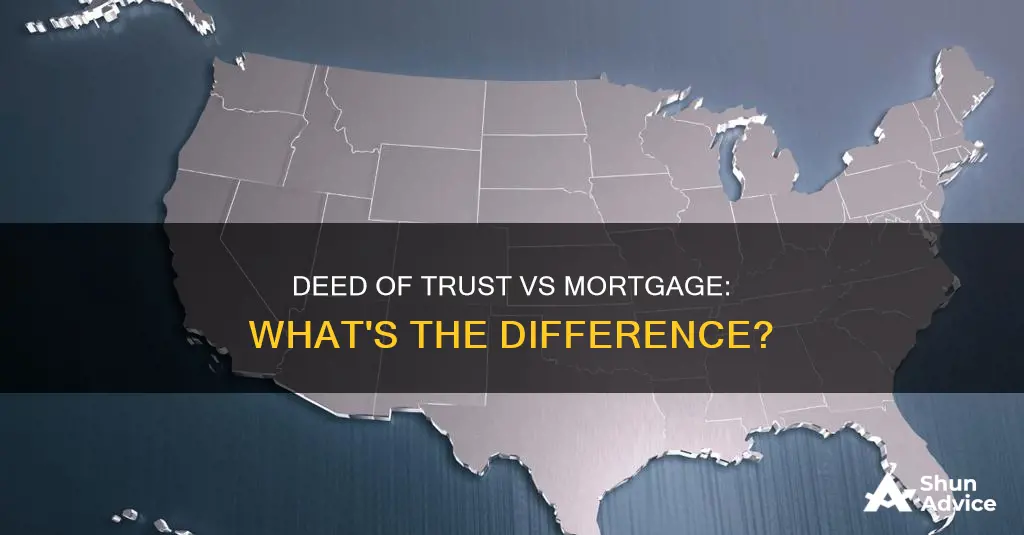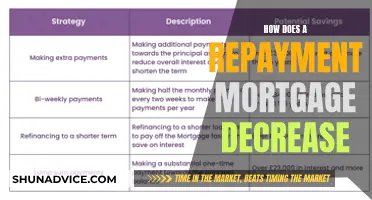
When buying a home, you may come across the terms mortgage and deed of trust. These are both legal agreements that tie the home you purchase to your loan as collateral, giving the lender a way to foreclose if you don't make your payments. However, there are some key differences between the two. Firstly, mortgages usually involve two parties, the borrower and the lender, while a deed of trust involves three, adding a third-party trustee who holds the property's title while the loan is being repaid. Another difference is in the foreclosure process; mortgages are usually foreclosed judicially, while deeds of trust typically go through a non-judicial foreclosure process.
What You'll Learn

Number of parties involved
The number of parties involved is the main difference between a mortgage and a deed of trust. A mortgage involves two parties: the borrower and the lender (usually a bank). The bank loans the money, and in return, receives a mortgage as security. If the borrower fails to make payments, the bank can take the loan to court to proceed with judicial foreclosure to force a sale of the property to recuperate the balance still owed.
A deed of trust, on the other hand, involves three parties. The borrower is called the trustor, and the lender is called the beneficiary. There is also a third party, called the trustee, that actually holds the deed of trust. If the borrower fails to pay on time, the trustee, not the beneficiary, is responsible for selling the house. The trustee is an unbiased third party that holds the property's title while the loan is being repaid. Trustees are usually title companies, trustee companies, or banks.
Renegotiating Your Mortgage: Strategies for Success
You may want to see also

Foreclosure process
The foreclosure process differs between mortgages and deeds of trust. A mortgage is a legal contract in which real estate is pledged as security for a loan, and it involves two parties: the borrower and the lender. A deed of trust, on the other hand, involves a third, neutral party—the trustee—who holds the title to the property until the loan is fully repaid.
In the case of a mortgage, the foreclosure process typically requires the lender to go through the courts, which can be a lengthy and costly process. This is known as a judicial foreclosure.
However, with a deed of trust, the foreclosure process is usually non-judicial, meaning it occurs outside of the court system. This can be faster and more cost-effective for the lender. In this case, the trustee initiates the foreclosure process by providing the required notices, such as a Notice of Default and a Notice of Sale. The trustee then organises a public auction to sell the property and repay the loan.
It is important to note that the specific procedures for foreclosure may vary depending on state law. For example, some states require that the borrower receives a notice of default before foreclosure, giving them a chance to rectify the situation. Additionally, the type of foreclosure may depend on the presence of a power of sale clause in the deed of trust.
Defending against foreclosure can be challenging, especially in the case of non-judicial foreclosure. One option to avoid foreclosure is to file for bankruptcy, which automatically halts foreclosure proceedings. Other options include mortgage reinstatement or redemption, which involve the borrower paying off past-due amounts or the entire outstanding loan, respectively.
Setting Up a Mortgage in QuickBooks: A Step-by-Step Guide
You may want to see also

State laws
Some states use mortgages to create a lien, while others use deeds of trust or similar instruments. A mortgage is a contract between you and the lender that creates a lien on the property. A "lien" gives the lender the right to foreclose if you fail to make payments or violate the loan contract. A mortgage is a two-party agreement, while a deed of trust involves three parties.
Deeds of trust are used in 33 states and the District of Columbia, while nine states allow both mortgages and deeds of trust. These nine states include Alabama, Arkansas, Illinois, Kentucky, Maryland, Michigan, and Montana. In the states that permit both, the lender usually chooses a deed of trust because of the easier foreclosure process if the borrower defaults.
The type of foreclosure you face depends on whether you have a deed of trust or a mortgage. Judicial foreclosures, which go through the state court system, are typical in states that use mortgages as security instruments. However, some states that use mortgages, like Alabama, Michigan, and Colorado, allow lenders to conduct out-of-court foreclosures.
In contrast, deeds of trust usually follow a non-judicial foreclosure process, which is faster and less expensive. In a non-judicial foreclosure, the trustee can sell the property without court involvement if the borrower fails to make payments. This process can be disadvantageous for the borrower, as it may be challenging to contest the foreclosure or ensure fair treatment without judicial review.
Shorting Mortgage Bonds: A Risky Bet on Interest Rates
You may want to see also

Nature of the document
The nature of the document for a deed of trust and a mortgage differs in several ways. Firstly, a mortgage is a legal contract between two parties: the mortgagor (the borrower) and the lender. On the other hand, a deed of trust involves three parties: the trustor or homebuyer/borrower, the trustee (a third party or intermediary), and the beneficiary or lender.
Secondly, a mortgage is considered a type of loan, whereas a deed of trust is an agreement or contract for a real estate transaction. A deed of trust is a document that may be seen at a home closing instead of a mortgage, and it is used to secure a home loan. The deed of trust states that the homebuyer will repay the loan, and the mortgage lender will hold the property's legal title until the loan is paid in full. Once the loan is fully repaid, the homeowner gains full title.
Thirdly, the foreclosure process for a deed of trust and a mortgage differs. Mortgages are usually foreclosed judicially, whereas deeds of trust typically go through a non-judicial foreclosure process. This means that with a mortgage, the lender needs to go through the courts to repossess the property, whereas with a deed of trust, the trustee, as an independent third party, has the right to foreclose on the property without court involvement.
Finally, the transfer of mortgages and deeds of trust are both called "assignments". When a mortgage is sold from one party to another, the transfer is documented and recorded in the county records. Similarly, when a deed of trust is transferred, an assignment is usually recorded in the county records.
Understanding Mortgage Balance Increase: What You Need to Know
You may want to see also

Ownership
A deed of trust and a mortgage are both agreements that tie the home you purchase to your loan as collateral. However, they differ in the parties involved, the ownership structure, and the foreclosure process.
Number of Parties Involved
A mortgage involves two parties: the borrower and the lender (usually a bank). In contrast, a deed of trust involves three parties: the trustor or borrower, the trustee or third party, and the beneficiary or lender. The trustee holds the deed of trust and has the power to sell the property if the borrower fails to pay.
In a mortgage, the borrower holds the title or legal ownership of the property. On the other hand, a deed of trust has a more complex ownership structure. The trustee holds the legal title, while the homeowner holds the equitable title during the loan repayment period. Once the loan is fully repaid, the homeowner gains full legal title.
Foreclosure Process
Mortgages typically go through a judicial foreclosure process, where the lender needs to go to court to initiate the foreclosure. Deeds of trust, on the other hand, usually involve a non-judicial foreclosure, where the trustee can sell the property without court involvement. This process is faster and less costly for the lender.
Mortgage Fraud: Reporting and Protecting Your Finances
You may want to see also
Frequently asked questions
A deed of trust is a legal agreement used in a real estate transaction in which a third party — the trustee — holds the title to the property until the borrower repays the mortgage in full.
A mortgage is a legal contract in which real estate is pledged as security (collateral) for a loan.
Three parties are involved in a deed of trust: the trustor (or the borrower), the trustee (the third party who holds legal title to the property) and the beneficiary (the lender).
A mortgage involves two parties: the mortgagor (the borrower) and the lender.
The main difference is that a deed of trust involves three parties, while a mortgage involves two. Another difference is that mortgages are usually foreclosed judicially, while deeds of trust typically go through a nonjudicial foreclosure process.







